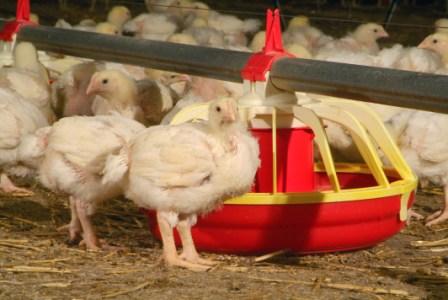New treatment options against surging ILT

A highly contagious and potentially deadly disease that affects the respiratory tract of chickens has become more prevalent in commercial operations throughout the Americas, specialists warn. The spread of the disease infectious laryngotracheitis, or ILT, has poultry producers looking for new ways to deal with the costly illness. A new vaccine provides a solution.
By Joseph Feeks
“It’s become a serious problem over the past 3 or 4 years in both North and South America,” says Dr. Guillermo Zavala, associate professor and poultry researcher at the University of Georgia. “It’s impacting every country, with very, very few exceptions, from Ontario, Canada, all the way down to Argentina.”
At a seminar on ILT at this year’s International Poultry Expo in Atlanta, Zavala told poultry veterinarians and producers there’s no clear explanation for the surge in ILT.
Broilers are the primary concern
Clinical signs of the disease include decreases in water and feed consumption, severe depression, conjunctivitis, respiratory distress and eventually death. The disease usually presents more problems during colder weather, Zavala said. It tends to cause the most havoc in broilers late in the production cycle, when economic losses can be greatest, but also shows up from time to time in breeders and layers (Figure 1).
The primary tools to control ILT have been vaccination and strict attention to biosecurity. Modified-live vaccines have been a mainstay in prevention of ILT, but their use has been associated with several problems, Zavala said, including vaccine reactions as well as the potential for increasing virulence as the virus passes from bird to bird.
Another presenter at the seminar, Ruud Hein, director of the technical services poultry laboratory at Intervet/Schering-Plough Animal Health, said one more important drawback to modified-live vaccines in the control of ILT is that vaccinated birds may harbour latent virus that can begin replicating at a later time, putting unvaccinated flocks at risk.
Stress plays a role
“We don’t know exactly why previously latent virus begins replicating,” he said, “but we believe that stress may play an important role in replication and subsequent shedding of virus.” Such shedding can occur weeks, months or even years later, Hein added.
One relatively new tool for managing ILT in broilers is a recombinant vector vaccine based on the turkey herpes virus (HVT) that causes Marek’s disease. The vaccine, Innovax-ILT, was developed by scientists at Intervet/Schering-Plough Animal Health and is administered subcutaneously to day-old chicks. The vaccine was first launched in the US in June 2007. Controlled studies show the vaccine protects 97% of chicks from ILT.
Unlike traditional viral vaccines that use killed or weakened live viruses to stimulate immunity, Innovax-ILT recombinant vector vaccine employs a completely different approach. It is created by inserting genetic material from the donor virus, ILTV, into the vector virus HVT of the Marek’s Disease vaccine.
When Innovax-ILT vaccine is injected into birds, the Marek’s portion of the vaccine produces protection against Marek’s disease. However, the vaccine also expresses the immunogenic proteins of the inserted genes of the donor virus, ILTV. Those ILTV proteins induce antibodies, which then trigger protection against ILTV. Because the vaccine does not contain the live ILTV, there is no chance of birds becoming ill from the vaccine. “The primary advantage of the vaccine is that it is not associated with vaccine-related reactions,” Zavala said, adding that reactions such as introducing subclinical disease, while perhaps not lethal to the bird, can significantly blunt performance.
Lifelong immunity
Because Innovax-ILT persists in the chicken but does not shed, administering a single dose on day 1 or in ovo usually leads to lifelong ILT immunity and doesn’t put unvaccinated birds at risk. With breeder and layer chicks, lifelong immunity also eliminates the need for revaccination of mature birds, an all too common necessity when using live attenuated ILT vaccines, Hein said.
One perceived drawback of the recombinant ILT vaccine is that it is more costly than live vaccines. Hein said, however, that when making such comparisons, it is important to factor in the single-dose efficacy of recombinant vaccines compared with multiple dosing that is often necessary with live products. That makes the cost of recombinant vaccine comparable to vaccination with live strains, he reported. As is the case with all vaccines, adhering to recommendations for proper storage and administration of recombinant ILT vaccine is crucial for achieving maximum effectiveness. At present, Innovax-ILT is licensed for use in the US and is expected to be approved soon in other countries such as Peru and Argentina.
Serological differentiation
The final speaker at the seminar was Dr. Jack Rosenberger, a former professor at the University of Delaware and now president of Aviservice LLC, a company that assists the poultry industry with strategies for disease recognition and control. He said that any effective ILT vaccine programme should include the ability to serologically differentiate between vaccinated birds that have been challenged and those that have not.
One commercially available ELISA kit, developed by Biocheck based in Gorham, Maine, is effective in documenting exposure to ILT, he said. Birds vaccinated with Innovax-ILT and tested with the kit typically exhibit limited antibody response to ILT, if they are not challenged.
Rosenberger went on to say that chickens vaccinated with recombinant ILT vaccine may respond serologically to challenge with ILT virus, but that the response is usually muted. Another factor, he said, which may affect susceptibility to challenge from ILT is the presence in birds of maternal antibodies to ILT.













